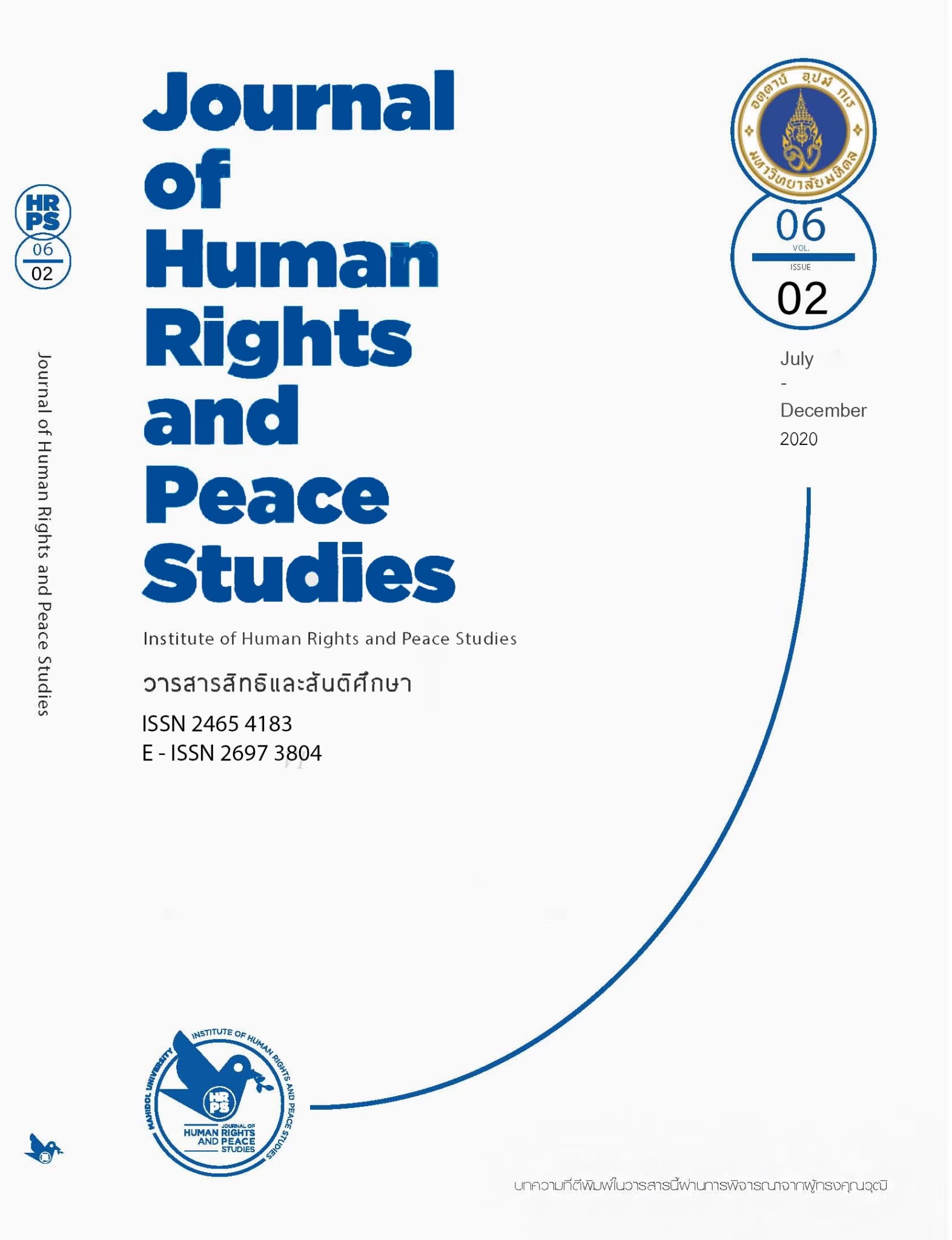An Investigation into the Struggle to Center Gender-Based Violence Policy in Refugee Settings
Main Article Content
Abstract
Despite decades of research and policymaking on how to address gender-based violence in times of emergency, humanitarian responses continue to neglect the implementation of international standards set forth by international Non-Government Organizations (NGOs), creating a large gap between recommended policy and policy implementation. This article draws on fieldwork undertaken at a refugee camp in Greece to interrogate and problematize the persistence of gender inequality in NGO operations. Its empirical findings demonstrate that NGOs are themselves embedded within, and complicit in perpetuating, the patriarchal social systems and structures that support gender-based violence in the first place. At the core of the gap between policy research and implementation is the persistence of patriarchy as a systematic structure of gender inequality, which obstructs gender awareness among workers and creates resistance to attempts to center and embed GBV standards in organizational programming and coordination efforts.
Article Details

This work is licensed under a Creative Commons Attribution-NonCommercial-NoDerivatives 4.0 International License.
The views, opinions, and pictures expressed in this journal are those of the authors and do not necessarily reflect the opinions and viewpoints of the editor and the editorial board. All rights are reserved by the authors and the Institute of Human Rights and Peace Studies of Mahidol University. No part of this journal may be reproduced, stored in a retrieval system, or transmitted in any form or by any means without the prior permission in writing from the journal’s editor, or as expressly permitted by law, or under terms agreed with the appropriate reprographics rights organization. Non-commercial use of information in this journal must be properly referenced.
References
Ackerly, B., & True, J., (2010). Doing feminist research in political and social science (2nd ed.). Red Globe Press.
Benschop, Y., & Verloo, M. (2006). Sisyphus’ sisters: Can gender mainstreaming escape the genderedness of organizations? Journal of Gender Studies, 15(1), 19–33. http://dx.doi.org/10.1080/09589230500486884
Bezirium, J. (2018). Gender-based violence policy in refugee settings: An investigation into the gap between policy and practice [Master’s thesis, Institute of Human Rights and Peace Studies, Mahidol University].
Bonewit, A. (2016). Reception of female refugees and asylum seekers in the EU: Case study Germany. European Parliament. http://www.europarl.europa.eu/RegData/etudes/STUD/2016/536497/IPOL_STU(2016)536497_EN.pdf
Brun, C. (2016). There is no future in humanitarianism: Emergency, temporality and protracted displacement. History and Anthropology, 27(4), 393–410. http://dx.doi.org/10.1080/02757206.2016.1207637
Dolan, C. (2014). Letting go of the gender binary: Charting new pathways for humanitarian interventions on gender-based violence. International Review of the Red Cross,96(894), 485–501. https://doi.org/10.1017/S1816383115000120
Eurostat. (2016, March 4). Record number of over 1.2 million first time asylum seekers registered in 2015 [Press release]. https://ec.europa.eu/eurostat/documents/2995521/7203832/3-04032016-AP-EN.pdf/790eba01-381c-4163-bcd2-a54959b99ed6
Gender-Based Violence AOR. (2010). Handbook for coordinating gender-based violence interventions in humanitarian settings. UNICEF. https://gbvaor.net/sites/default/files/2019-07/Handbook%20for%20Coordinating%20GBV%20in%20Emergencies_fin.pdf
Howden, D., & Fotiadis, A. (2017, March 6). The refugee archipelago: The inside story of what went wrong in Greece. News Deeply. https://www.newsdeeply.com/refugees/articles/2017/03/06/the-refugee-archipelago-the-inside-story-of-what-went-wrong-in- greece
Humanitarian Practice Network. (2014). Special feature: Gender-based violence in emergencies (Humanitarian Exchange No. 60). Humanitarian Practice Network. http://odihpn.org/wp-content/uploads/2014/02/HE_60_web_1.pdf
Inter-Agency Standing Committee. (2015). Guidelines for integrating gender-based violence interventions in humanitarian actions: Reducing risk, promoting resilience and aiding recovery.https://gbvguidelines.org/wp/wp-content/uploads/2015/09/2015-IASC-Gender-based-Violence-Guidelines_lo-res.pdf
Johnson, A. G. (2005). The gender knot: Unraveling our patriarchal legacy. Temple University Press.
Muiznieks, N. (2016, July 3). Human rights of refugee and migrant women and girls need to be better protected. Council of Europe. http://www.coe.int/en/web/commissioner/-/human-rights-of-refugee-and-migrant-women-and-girls-need-to-be-better-protected
Ortner, S. B. (2014). Too soon for post-feminism: The ongoing life of patriarchy in neoliberal America, History and Anthropology, 25(4), 530–549. https://doi.org/10.1080/02757206.2014.930458
Pelaez, M. W. (2016, December 16). NGOS call for better protection for female refugees in Europe. Equal Times, https://www.equaltimes.org/ngos-call-for -better-protection#.WRV-L1OGPBJ
Robinson, D. (2016, January 20). Women and children refugee numbers crossing into Europe surge. Financial Times, https://www.ft.com/content/dff3b5ea-bf99-11e5-9fdb-87b8d15baec2
Santos, R. F. (2019, July 18). Challenging patriarchy: Gender equality and humanitarianprinciples. Humanitarian Law and Policy, https://blogs.icrc.org/law-and-policy/2019/07/18/gender-equality-humanitarian-principles/
United Nations Population Fund. (2012). Managing gender-based violence programs in emergencies: E-learning companion guide. http://www.unfpa.org/sites/default/files/pub-pdf/GBV%20E-Learning%20Companion%20Guide_ENGLISH.pdf
United Nations Population Fund. (2015). Minimum standards for prevention and response to gender-based violence in emergencies. http://www.unfpa.org/sites/default/files/pub-pdf/GBVIE.Minimum.Standards.Publication.FINAL_.ENG_.pdf
United Nations Population Fund. (2016, May 23). 10 things you should know about women & the world’s humanitarian crises.http://www.unfpa.org/news/10-things-you-should-know-about-women-world’s-humanitarian-crises
United Nations High Commissioner for Refugees. (2008). UNHCR handbook for the protection of women and girls, http://www.unhcr.org/47cfa9fe2.html
United Nations High Commissioner for Refugees. (2015a). Initial assessment report: Protection risks for women and girls in the European refugee and migrant crisis,http://www.unhcr.org/569f8f419.html
United Nations High Commissioner for Refugees. (2015b, September 11). UNHCR welcomes the European Commission's proposals and calls for their full and swift implementation, http://www.unhcr.org/55f2c5ae6.html
United Nations High Commissioner for Refugees. (2016, December 15). Greece:Europe refugee emergency – Daily map indicating capacity and occupancy (Governmental figures), http://www.refworld.org/country,,UNHCR,,GRC,,585a5b204,0.html
United Nations Children's Fund. (2015). UNICEF regional guidance: Operationalizing the IASC GBV guidelines in Latin America and the Caribbean.http://www.unicef.org/lac/UNICEF_Guia_GBV_ingles_julio2015.pdf
United Nations Children's Fund. (2016). Human Rights-based Approach to Programming.https://www.unicef.org/policyanalysis/rights/index_62012.html
United Nations Entity for Gender Equality and the Empowerment of Women. (2016). Gender assessment of the refugee and migration crisis in Serbia and FYR Macedonia. http://eca.unwomen.org/en/digital-library/publications/2016/01/gender-assessment-of-the-refugee-and-migration-crisis-in- serbia-and -fyr-macedonia
Ward, J. (2016). It’s not about the gender binary, it’s about the gender hierarchy: A reply to “Letting Go of the Gender Binary.” International Review of the Red Cross, 98(901), 275–298. https://doi.org/10.1017/S1816383117000121
Ward, J., & Vann, B. (2002). Gender-based violence in refugee settings.The Lancet, 360(S13–S14). https://doi.org/10.1016/S0140-6736(02)11802-2
Women’s Refugee Commission. (2016a, January). No safety for refugee women on the European route: Report from the Balkans. https://www.womensrefugeecommission.org/wp-content/uploads/2020/04/Refugee-Women-on-the-European-Route.pdf
Women’s Refugee Commission. (2016b, March). Falling through the cracks: Refugee women and girls in Germany and Sweden. https://s33660.pcdn.co/wp-content/uploads/ 2020/04/Refugee-Women-in- Germany-and-Sweden.pdf
Women’s Refugee Commission. (2016c, August). EU-Turkey agreement failing refugee women and girls. https://s33660.pcdn.co/wp-content/uploads/2020/04/EU-Turkey-Refugee-Agreement-Failing.pdf


